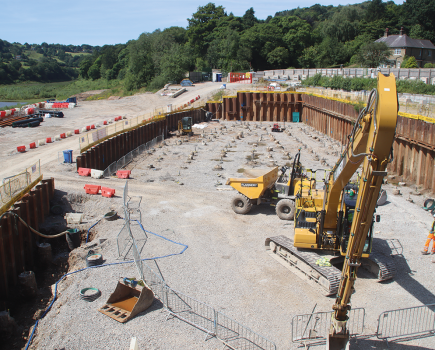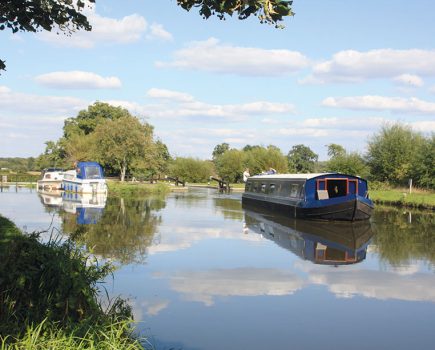In the second part of our guide to this great east-west route, we follow the more dramatic western length as it plunges down Devizes locks, crosses impressive aqueducts, descends into historic Bath city, and follows the Avon to Bristol Harbour

Looking back at the first part of this article in the last issue, we started at the junction of the River Kennet with the River Thames on the outskirts of Reading, and then followed the steady climb through Reading and up the Kennet Valley to Newbury and Hungerford. This was followed by the lovely Vale of Pewsey, leading to Devizes where we paused at Devizes Wharf.
This time we’ll continue westwards from Devizes, where by contrast to the gentle landscapes of the first part, the final 40 miles to Bristol contain most of the iconic landmarks of the Kennet & Avon, beginning with the 29 locks at Devizes and including two major aqueducts at Dundas and Avoncliff. The journey also passes through Bradford-on-Avon and the beautiful Avon valley from there to the City of Bath, before the navigation ends at Bristol’s Floating Harbour.
We begin the journey at Devizes Wharf – but there’s a lot to see and do before embarking on the trip down the locks. Don’t miss the Canal Centre which is the headquarters of the Kennet & Avon Canal Trust. A museum traces the history of the canal and its eventual restoration, and there is also a shop and a cafe, all in a restored warehouse. Another converted warehouse now houses a waterside theatre, and the Trust also operates a trip boat from a mooring place nearby. The annual Devizes to Westminster canoe race which takes place over the Easter weekend has its starting point opposite the theatre. Finally, before leaving the wharf consider taking a short walk from the wharf to visit the Wadworth Brewery and Visitor Centre.

Back at the boat, take a deep breath: there are a grand total of 29 locks to negotiate. These are grouped in three sets: six spread-out locks leading on from Devizes Wharf, before a spectacular series of sixteen closely-space locks descending Caen Hill, followed by another seven more spaced-out locks leading to the bottom lock at Foxhangers. The Caen Hill locks have lock-keepers to assist boaters but once committed to the flight at the top lock there is no mooring allowed until reaching the foot of the flight. A cafe strategically situated by the top lock of the Caen Hill flight does offer a welcome sit down before tackling the flight.
Foxhangers, at the bottom of the locks, features a boatyard and a marina, as well as moorings where boaters can recuperate from their exertions.
The next place to stop is Seend Cleeve where there are five more locks – in an idyllic setting today, but once the centre for mining ironstone, with two blast furnaces connected by tramways leading to the canal. Nearby is the popular Barge Inn, once the home of Fred Kempster, England’s tallest man. At his death in 1918 at the early age of 29, he was 8 feet 2 inches tall and weighed 27 stone.

After Seend Cleeve only a couple of swing bridges interrupt the lovely countryside before reaching Semington and the junction with the now derelict Wilts & Berks Canal. This 51-mile-long canal opened in 1810 and provided an alternative route to the River Thames, reaching Abingdon via Swindon. It was abandoned in 1914 and some of the line has been filled in; nevertheless, the canal is slowly being restored by volunteers, led by the Wilts & Berks Canal Trust.
Semington has two aqueducts: one dating from 1807 and spanning the Semington Brook, and a much grander version completed in 2004 over a new road, involving the canal being diverted during construction. Two locks at Semington lead to a pleasant lock-free five miles to Bradford-on-Avon.
After a pleasant two miles of open countryside, the canal arrives at Hilperton which is a busy boating centre, with a large marina, two boatyards and a pub. It’s on the outskirts of Trowbridge whose town centre can be reached with a short walk from Bridge 168.

After Hilperton a high embankment with views of the River Avon is followed by a wooded cutting that takes the canal into Bradford-on-Avon. First there is a marina and waterside pub followed by Bradford Lock which ends the five mile lock-free section. Here the Kennet & Avon Canal Trust has a shop and cafe. Just beyond the lock and bridge is the Canal Tavern with a garden, followed by an ancient tithe barn. This is one of Britain’s finest examples of a monastic barn, built in the 14th century, and is open to visitors. There is also a handy waterside supermarket conveniently situated for boaters wanting to stock up with provisions.
Don’t rush through Bradford-on-Avon because there is a lot to see and do. Take time to walk down the hill and visit the town, which is bisected by the River Avon. The river is crossed by a nine-arched stone bridge, originally built in Norman times but widened in 1769. It has one of four examples of a bridge chapel left in Britain.
After Bradford comes the first of two superb aqueducts built in Bath stone over the River Avon. A thickly wooded section of canal arrives at a sharp bend leading to the three-arched aqueduct. Here you can stop a while at a 16th century waterside pub in an idyllic setting with panoramic views of the river and aqueduct from its garden. There is also a tea room and a group of cottages.

The canal continues on a high wooded embankment overlooking the Avon Valley with the river and railway far below. This glorious stretch of waterway ends at Dundas Aqueduct, which is even more spectacular than its predecessor at Avoncliff. Built in 1804, Dundas Aqueduct has classical columns, cornices and balustrades above three huge arches.. Named after Charles Dundas, the first chairman of the Kennet & Avon Canal Company, it remains as a magnificent tribute to engineer John Rennie.
At the end of the aqueduct Brassknocker Wharf marks the junction with the former Somersetshire Coal Canal that once served collieries in the Radstock and Paulton areas south of Bath. The line, which has been closed for over a hundred years (but is subject to restoration plans by the Somersetshire Coal Canal Society), can be traced but only the first quarter of a mile is still in water and used for moorings. A boatyard and restaurant are at the end of the present line.
Next, the canal reaches Claverton Pumping Station which was built to pump water into the canal from the River Avon. In its heyday it was powered by a huge water wheel pumping 77,000 gallons of water from the river every hour. Today, modern electric pumps do the work but the old pump has been restored by volunteers and is demonstrated to the public on special pumping days between April and October. Also worth a visit is the American Museum in Claverton village, a short walk from the canal.

River and railway are close neighbours as the canal continues in a northerly direction to Bathampton where there is a popular waterside pub. The canal now swings in a wide loop towards the west as it enters the city of Bath with wide views across the city’s rooftops, before passing through Sydney Gardens with its decorative footbridges. It is worth a stop here to visit the Holburne Museum, a Grade 1 listed building with a fine art collection, surrounded by beautiful gardens. Next comes the short Cleveland House Tunnel, with the building which was once the headquarters of the Kennet & Avon Canal Company built above the tunnel entrance – and equipped with a trap-door in the tunnel roof to allow clerks in the room above to exchange paperwork with the boatmen passing below.
Bath Top Lock marks the start of the descent to the River Avon by what were once the seven Widcombe Locks, but today form a flight of six. Local road alterations taking place around the time of the canal’s restoration from dereliction in the 1970s led to a new lock being built as an amalgamation of two former locks, making it at 19 feet one of the deepest canal locks in the country. The superlative views surrounding the canal and across the city rooftops make this flight one of the finest in Britain.
The navigation joins the River Avon at the bottom lock, but before continuing on the journey towards Bristol, consider taking a turn to the right for a short distance to the weir below Pulteney Bridge. It is no longer possible to moor there, but it’s worth it for the view of Robert Adam’s Pulteney Bridge, completed in 1774 and lined with shops in the style of the Ponte Vecchio in Florence. It is one of only four bridges in the world to have shops across its full span on both sides. Bath Abbey and the famous Pump Room can be seen just beyond the riverside gardens. The rest of Bath’s many attractions are within walking distance of visitor moorings downstream of the junction with the canal. Trip boats also operate above the weir on a section of the river unavailable to visiting boats.

Back at the bottom lock of the Widcombe flight, boaters heading to Bristol will soon be aware from the wide channel that they have left the canal and joined a river navigation.
The main features of this first section of waterway are a succession of bridges and a number of old warehouses, emphasising the amount of trading that once took place in this part of Bath. More moorings are available along this section and there are supermarkets, shops and pubs close to the navigation. After Weston Lock, the city’s suburbs begin to recede and are replaced by wooded hills. There are waterside pubs near Weston Lock and another a little further ahead at Newbridge which also has a large marina with a shop as well as boating facilities.
After Newbridge the city is left behind, and the navigation follows a series of bends into open countryside. Kelston Lock has a marina and a pub, and makes a good place to stop and visit Saltford village. A little further on, Saltford Lock is in a beautiful setting with the remains of a brass mill and a popular pub, plus a sailing club so expect to see lots of yachting activity at weekends.

This beautiful reach of the river is known as the Avon Valley Country Park, and it follows a winding course to Swineford, where there is another lock, and then on to Keynsham.
Keynsham was once famous for the huge Somerdale chocolate factory, but this closed in 2011 with the loss of 400 jobs when production moved to Poland. The building was demolished and replaced by housing, a school and a shopping centre, so that delicious smell of chocolate that once wafted across Keynsham Lock is, alas, no more.
After Keynsham, the river takes a sharp bend to the north and arrives at Hanham Lock which has an attractive setting at the foot of a steep wooded hillside with a group of old cottages and two pubs. The river below Hanham Lock is tidal, and occasionally very high tides sometimes pass over the weir at Hanham making the river tidal as far as Keynsham Lock – so take advice before mooring on these lengths.

You will need a visitor licence to from the harbour authority to cruise into Bristol: you can get them from the waterway office at Hanham or from the lock-keeper at Netham Lock (if the locks are manned), or from the harbour master’s office in Bristol.
The tidal river passes along a steeply wooded valley to Netham Lock, which may be open or closed depending on the state of the tide. Here the navigation leaves the natural river and takes the artificial Feeder Channel into Bristol’s Floating Harbour.
The Floating Harbour was created by William Jessop in the early 19th century to allow ships to remain afloat whilst loading and unloading their cargoes. This was needed because the tidal rise and fall on the Avon in Bristol can be a much as 40 feet. The ability of ships to work around the clock in the Floating Harbour may have given rise to the phrase ‘ship-shape and Bristol fashion’ – or alternatively it may have referred to the need for ships to be well built and cargoes well-stowed in the days before the Floating Harbour when they would need to sit on the bottom.

The port closed in 1975 and the Floating Harbour has now been regenerated for leisure and residential use. The opening of the harbour to pleasure craft has created many attractions such as art galleries, museums, restaurants, pubs and shopping areas. Public trip boats operate around the harbour.
For all but the few adventurous, experienced and well-prepared boaters heading down the tideway to Avonmouth (for the journey to Sharpness), Bristol is the end of the journey. But before turning round and heading back east, boaters should find a mooring place in the harbour and enjoy Bristol’s attractions including the impressive cathedral. Visit Brunel’s SS Great Britain, walk to the Clifton Suspension Bridge, visit the ‘M Shed’ Industrial Museum, and don’t miss the Arnolfini art centre and gallery on Narrow Quay.


Image(s) provided by:
Archant







